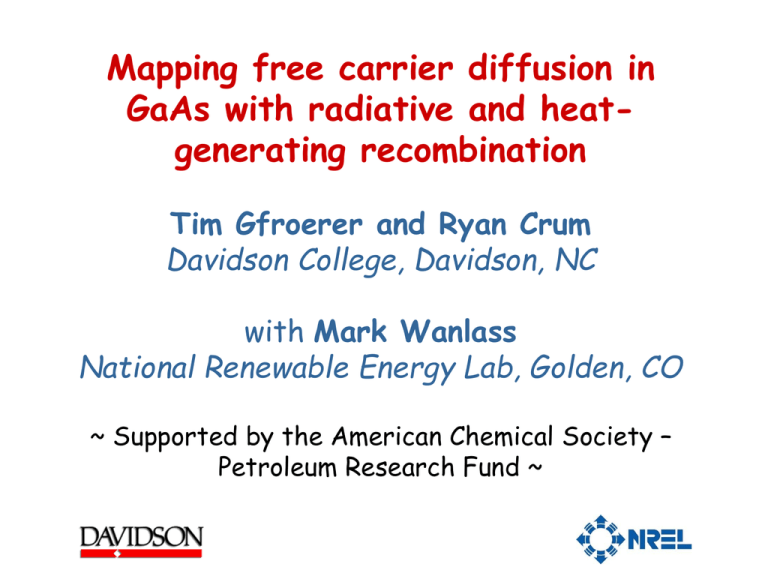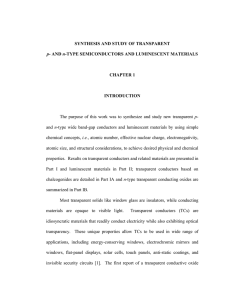Mapping free carrier diffusion in GaAs with radiative and heat- generating recombination
advertisement

Mapping free carrier diffusion in GaAs with radiative and heatgenerating recombination Tim Gfroerer and Ryan Crum Davidson College, Davidson, NC with Mark Wanlass National Renewable Energy Lab, Golden, CO ~ Supported by the American Chemical Society – Petroleum Research Fund ~ Solar Cell Operation Conduction Band - E-Field - HEAT ELECTRON ABSORPTION PHOTON CURRENT HOLE - Valence Band + E-Field + + + When a photon is absorbed, an electron is excited into the conduction band, leaving a hole behind in the valence band. Some heat is lost, reducing efficiency. Then an internal electric field sweeps the electrons and holes away, creating electricity. Light- and Heat-Generating Recombination Conduction Band ENERGY - Photon Conduction Band - Defect Level HEAT HEAT + + Valence Band Valence Band Rate ≈ B x n 2 (n = carrier density) Rate ≈ A x n (n = carrier density) Electrons can recombine with holes by releasing light or heat. This loss mechanism also reduces the efficiency of a solar cell. Experimental Setup Laser spot ~ 4 mm diameter - + + + + - - + - + +-+ - - + Luminescence Camera + GaAs sample (plan view) - Thermal Camera - - + Time evolution of thermal profile 0 Temperature Difference (K) 10 Time Window: Laser on! Heat loss -1 10 0-33 ms 33-67 ms 67-100 ms 100-133 ms Thermal diffusion -2 10 -3 10 0 100 200 Distance (mm) 300 400 Luminescence and Thermal Profiles 0 Normalized Light or Heat Signal 10 Laser Excitation Light Emission T (Heat) -1 10 -2 10 -3 10 -4 10 -5 10 0 100 200 300 Distance From Excitation Position (mm) 400 Square-root of the Luminescence 0 Normalized Light or Heat Signal 10 Laser Excitation Light Emission 1/2 (Light Emission) T (Heat) Rate ≈ A x n -1 10 -2 10 -3 10 Rate ≈ B x n 2 -4 10 -5 10 0 100 200 300 Distance From Excitation Position (mm) 400 Free-Carrier or Thermal Diffusion?! 0 Normalized Light or Heat Signal 10 Laser Excitation Light Emission 1/2 (Light Emission) T (Heat) Thermal Diffusion -1 10 -2 10 -3 10 -4 10 -5 10 0 100 200 300 Distance From Excitation Position (mm) 400 Conclusions • We use optical and thermal imaging to map the free-carrier density near a localized photo-excitation source. • The density profiles agree when we account for the bimolecular nature of radiative recombination. • BUT: a thermal diffusion calculation also mimics the temperature profile … • So what have we measured?! We’ll figure it out!








